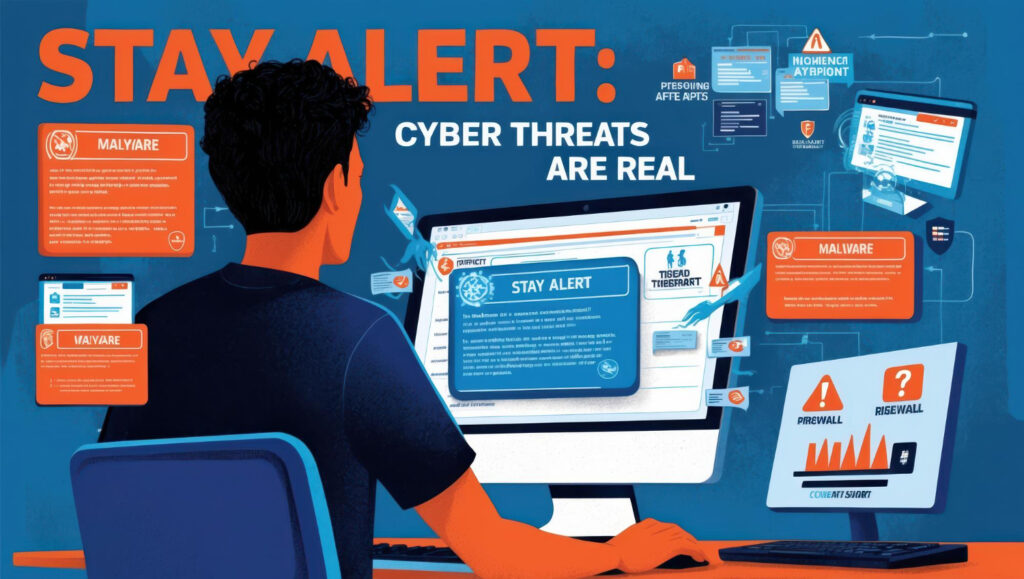
Every 39 seconds, a cyber attack hits someone online. That’s not just a tech issue, it’s a real threat to any business. From stolen data to full system outages, the damage can be hard to fix and even harder to recover from. That’s where cyber security services come in. These services don’t just put out fires, they help stop them before they start.
Whether it’s spotting weak points, responding to attacks, or helping teams stay alert, each type of service plays a role in keeping your business running safely. In this article, we’ll walk through the main types of cyber security services and break down how they work, so you can see what matters most for your business.
What Is Cybersecurity?
Cybersecurity is simply maintaining your data, systems, and devices from online threats. It’s like a digital lock that safeguards everything from customer information to business emails. In the present age, where everything operates online, one weak link can turn into a big problem, like compromised data, loss of money, or even halting operations. Not only are large corporations targeted, but small businesses are hit as well, simply because they are easier to attack. That is why every organization must have a good plan to defend itself.
Cybersecurity isn’t just one tool or software, it’s a mix of services and practices working together to spot risks, block attacks, and respond fast when something goes wrong.
Now the big question, what kinds of services are actually used to do all this? Let’s go through the top 10.
List of Top 10 Different Types of Cyber Security Services
Cybersecurity isn’t a one-size-fits-all deal. Different services work together to keep data and systems safe from all kinds of threats. Here are ten of the most used and trusted types.
1. Risk Assessment
Before building any security plan, it is important to understand where your systems stand. Risk assessment helps identify weaknesses in your network, software and internal processes. These evaluations often go hand-in-hand with a network security audit, which provides a more structured review of your infrastructure.This highlights areas that need to pay attention and guide your next stages.
This service is often the first step companies take to improve their overall cybersecurity. By knowing what’s at risk, businesses can make smarter choices and avoid threats before they turn into real problems.
2. Managed Security Services (MSS)
Not all businesses can afford to watch 24/7 or maintain the staff. MSS vendors do this for you, monitoring threats, updating tools, and responding to alerts. Having a full-time security team without the expense of employing one. particularly beneficial for small businesses who tend to be behind on security updates.
Related Article : Top 10 Best SOC Service Providers in Australia
Benefits of Outsourcing Cybersecurity Services for Your Business
3. Incident Response
What happens after an attack matters just as much as what you do to prevent one. Incident response services help contain the damage, recover data, and get things back to normal quickly. The faster you act, the less it costs, on average, companies that respond quickly save over $1 million in damage control.
4. Penetration Testing (Pentesting)
This is like hiring someone to break into your system, on purpose. Pentesters look for cracks the way hackers would and report them before real attacks happen. It’s a safe way to test how strong your defense really is.
Regular pentesting can cut down the risk of a major breach by nearly 70%. It also helps your team understand how attackers think. The better you know their methods, the better you can stop them.
5. Vulnerability Scanning
Vulnerability scans run checks to find weaknesses in your software, networks, or hardware. Some scans are automated, others manual. Both help in spotting issues early. Many businesses that skip regular scans don’t find problems until it’s too late, and fixing them post-breach costs more.
6. Access Management
Not everyone needs access to everything. Access management makes sure only the right people can reach sensitive data or systems. Adding things like multi-factor authentication (MFA) reduces the chances of someone breaking in.
In fact, MFA can block over 99% of automated attacks, according to Microsoft. It also helps control internal threats by limiting what employees can see. If a login is misused, access control makes it easier to trace and respond.
7. Cybersecurity Awareness Training
Human error is one of the biggest causes of cyber incidents. Awareness training teaches employees how to spot phishing scams, use strong passwords, and handle data safely. A well-trained team is your first line of defense, and one mistake avoided can save a business from major loss. These sessions don’t need to be technical, just clear and consistent. The goal is to build habits that stick and create a culture of caution.
8. Identity Theft Protection
When personal info is stolen, it can quickly be used to commit fraud. These services monitor your data, scan for threats on the dark web, and alert you to any strange activity. It’s not just for individuals, businesses also use it to protect customers and staff from identity-related breaches.
9. Cybersecurity Education and Certification
Ongoing training keeps IT and security teams ready for new challenges. Certifications and courses help them stay up to date with threats and tools. Cybercrime evolves fast, so the people handling it need to stay one step ahead. Companies with trained staff respond faster and smarter when attacks happen.
10. Cloud Security Services
More and more companies utilize cloud apps and storage, so keeping all that data protected is essential. Cloud security prevents unauthorized access, leaks of information, and other threats associated with the use of clouds. A 2024 report states that in over 45% of data breaches, cloud-based systems were involved, so neglecting this field is not a choice any longer.
Related Article : Complete Guide to Cloud Technology Solutions
What Types Of Cyber Security Threats Are There?

Not every cyberattack is flashy or obvious. Some slip in quietly, others come in full force. Understanding these threats helps you prepare, stay alert, and avoid common traps that can cost you more than just money.
Malware
This is harmful software designed to mess with your system. It can delete files, steal data, or spy on you without your knowledge. Clicking on a sketchy link or downloading something shady is often all it takes.
Phishing
Ever got an email that looks legit but isn’t? That’s phishing. It tricks you into giving away personal info like passwords or card details. These scams are getting smarter and can target anyone in a company.
Ransomware
This one locks your files and demands payment to get them back. It can bring business operations to a standstill. Without backups or a recovery plan, you could lose access to everything in minutes.
Denial-of-Service (DoS) Attacks
These attacks flood a site with so much traffic it just stops working. It’s like hundreds of fake customers crowding a store so real ones can’t get in. It’s disruptive and can last for hours or even days.
Man-in-the-Middle (MitM) Attacks
Imagine you’re talking to someone, but someone else is secretly listening in and changing your words. That’s what this attack does—intercepts communication between two parties, often on public Wi-Fi, without anyone noticing.
Password Attacks
Weak passwords are an easy target. Hackers use tools to guess them or test known ones from data leaks. If you reuse passwords or use easy ones, you’re basically leaving the door half open.
Insider Threats
Sometimes, the risk is someone on the inside. It could be an angry ex-employee or even someone who makes a mistake without realizing it. That’s why access should be limited and monitored properly.
Related Article : Top 10 Benefits of Cybersecurity for Businesses
Best Practices for Cybersecurity Implementation
Cybersecurity isn’t a matter of tools—it’s the way you use them. Do a few things right, and they can make a huge difference in protecting your systems, people, and data against day-to-day threats.
1. Keep Software Updated
Regular updates patch known flaws that hackers often use. Set up automatic updates where possible, and make sure security tools, apps, and operating systems stay current across all devices.
2. Use Strong Passwords and MFA
A strong password is the first line of your protection. Add multi-factor authentication (MFA) to make the attackers difficult to break, even if they get the password right.
3. Back Up Your Data
Things go wrong, files get corrupted, systems crash, ransomware hits. Regular backups mean you don’t lose everything. Store copies offline or in a secure cloud location.
4. Train Employees Regularly
Most attacks start with a simple mistake. Basic training on phishing, password safety, and safe browsing can prevent avoidable incidents and make security part of daily work.
5. Limit Access to Sensitive Information
Not everyone needs access to everything. Give people only what they need to do their job. This cuts the chances of data being misused, accidentally or otherwise.
6. Monitor and Respond to Threats
Keep an eye on your systems. Use tools that alert you to suspicious activity. And always have a plan for what to do if something goes wrong—it saves time and reduces damage
Conclusion
Cyber security is not something that you install and forget. This is a continuous process to protect your business from the dangers that are developing continuously day by day. Easy measures such as scanning for dangers, managing who accesses your information, and educating your employees can be a huge difference maker. Ignoring security isn’t just risky, it can cost your business its reputation and customers’ trust.
At Hyetech, it’s all about assisting companies with creating robust defense systems without the inconvenience. With proper guidance, safeguarding your data and systems need not be hassle-driven. Take action now to keep your business safe before problems find you.
FAQs
Why Are There Different Types Of Cyber Security Services?
Different types of cybersecurity services exist because threats come from many sources, hackers, malware, system flaws, and even human mistakes. Each service focuses on a specific area to give complete protection. Together, they cover everything from risk prevention to response when something goes wrong.
How Is Managed Security Different From In-House Security?
Managed security is handled by third-party experts who monitor and protect your systems 24/7 using advanced tools. In-house security relies on your internal team. While in-house teams understand your setup better, managed services offer broader experience, constant monitoring, and quicker responses during potential threats or attacks.
Are All Businesses Required To Have Cyber Security Services?
Not every company is lawfully obliged to have cybersecurity services, but it’s highly advisable. With increasing online threats, even smaller companies are vulnerable. Cybersecurity protects sensitive information, customer confidence, and everyday business. Certain sectors, such as finance or healthcare, might have regulatory guidelines for data protection and must adhere to rigorous security measures.
